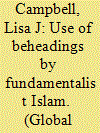|
|
|
Sort Order |
|
|
|
Items / Page
|
|
|
|
|
|
|
| Srl | Item |
| 1 |
ID:
156907


|
|
|
|
|
| Summary/Abstract |
This article focuses on the so-called “brutalization” of terrorism. The brutalization thesis as part of the larger theoretical concept of “new terrorism” argues that “new terrorism” is more brutal than “old terrorism.” Many scholars claim that the 9/11 attacks mark the beginning of a new era of terrorism that has lifted international as well as domestic terrorism to a new level of violent brutality. Others argue that this process had already started in the early 1990s. After discussing possible ways to operationalize a brutalization of terrorism, for example focusing on suicide bombings or terrorist attacks against soft targets, this article tests the empirical credibility of the brutalization thesis regarding both potential starting points. Data from the Global Terrorism Database (GTD) shows that only three out of nine indicators increased significantly during the 1990s, partially backing the idea of a general brutalization, whereas increasing numbers of suicide attacks and beheadings after 9/11 support the notion of a qualitative change in terrorism and its brutality connected with the idea of maximizing media and public attention. Yet, these developments are regionally limited and the brutality of this “new terrorism” exceeds the levels known from the zenith of “old terrorism” in the 1970s and 1980s in only a few cases.
|
|
|
|
|
|
|
|
|
|
|
|
|
|
|
|
| 2 |
ID:
093830


|
|
|
|
|
| Publication |
2010.
|
| Summary/Abstract |
This essay provides an overview of those incidents of torture and beheadings linked to the Mexican cartels and their mercenary and gang affiliates taking place both within Mexico and the United States. Specific forms of torture are discussed as well as the most likely victims and perpetrators. Beheadings, primarily taking place only in Mexico, are also analyzed with supporting database information provided. The occurrences of torture and beheadings tied to these cartels, both in Mexico and more recently across the border into the United States, beg the question of the context in which they are being conducted. Most cases of torture or beheading are regarded as primarily secular in nature - a terrorist tactic tied to economic or political gain. In an even more macabre twist, however, certain instances have been seen as intertwined with a group's belief system, performed in ritual fashion to fulfill religious or spiritual demands. This suggests that the emergent Mexican narcocultos that are evolving may further increase drug war violence to new levels of brutality heretofore unseen.
|
|
|
|
|
|
|
|
|
|
|
|
|
|
|
|
| 3 |
ID:
077345


|
|
|
|
|
| Publication |
2006.
|
| Summary/Abstract |
Beheadings have made a dramatic resurgence in the past four years especially with the introduction of videotaped executions broadcast in the mass media. The use of beheadings has a longstanding history. Beheadings have been used in a state and non-state capacity, for punishment or intimidation, against leaders, civilians and warring combatants, during times of peace and that of upheaval. Beheadings today reproduce the characteristics of past beheadings as well as deviate from them. Contemporary beheadings have taken on a more criminal nature while beheadings of the past had more legitimacy and some even were considered honorable. Current beheading tactics include unexpected and illegal targets, unorthodox and barbaric techniques, and irregular display to an unprepared public. Although Islamic militants are the predominant beheaders, there is evidence that beheadings are being conducted by non-Islamic entities and in unexpected locations. If the current trend in the use of beheadings continues, it will be necessary to develop countermeasures, which will be facilitated with an understanding of the political, cultural, and criminal motives of the beheading offenders along with their tactics
|
|
|
|
|
|
|
|
|
|
|
|
|
|
|
|
|
|
|
|
|